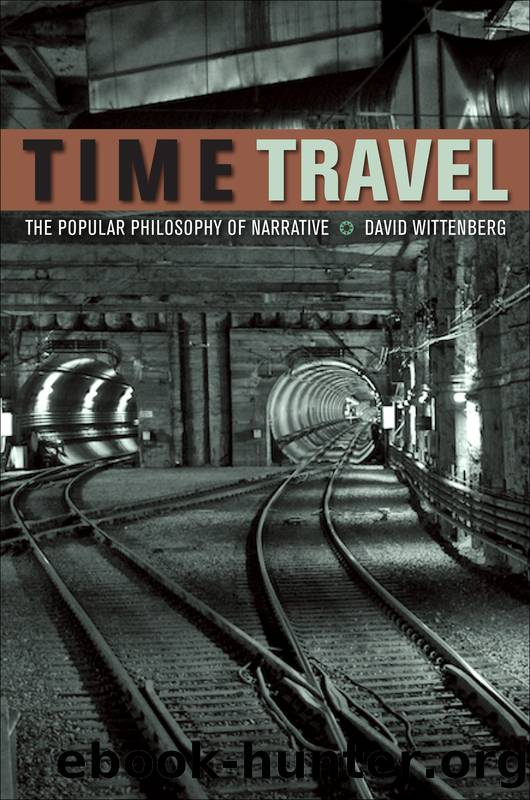Time Travel by David Wittenberg

Author:David Wittenberg
Language: eng
Format: epub
Publisher: Fordham University Press
Published: 2013-02-14T16:00:00+00:00
Conserving Fabula in âTimeâs Arrowâ
The double episode of Star Trek: The Next Generation entitled âTimeâs Arrowâ (1992) begins with a discovery opening the possibility of paradox but then works hard to shut it down, or, more precisely, works to indicate how and why no paradox could ever have occurred.15 In the twenty-fourth century (the showâs present moment), the android Commander Dataâs head is discovered lying in an abandoned mine in San Francisco, seemingly untouched since sometime late in the nineteenth century. The simultaneous presence onscreen of the abiding Commander Data (intact, of course) and his 500-year-old vestigial head may already indicate a paradox of sorts: Dataâs head is in two places at the same time, both on and off his neck, and the early scenes are constructed to take advantage of this uncanny coincidence. But this isnât yet what one calls a time travel paradox per se. Indeed, in terms of time travel, the spatial simultaneity of the two temporally divergent heads is resolvable (by Data himself, as it turns out) through a narrative maneuver:
Data: It seems clear that my life is to end in the late nineteenth century.
Riker: Not if we can help it.
Data: There is no way anyone can prevent it, sir. At some future date, I will be transported back to nineteenth-century Earth, where I will die. It has occurred; it will occur.
Dataâs assertion âit has occurred; it will occurââor to combine the tenses into their implied future perfect, âit will have occurredââcaptures precisely the inevitability or facticity, the pastness, of the historical events confirmed by the incontrovertible fact that Dataâs 500-year-old head has lain untouched in that cavern. From here, the episodeâs sjuzhet sets out to explain what brought Data to nineteenth-century San Francisco and, as it turns out, what then returned his head five centuries into the future to be reunited with his decapitated body. Ultimately, there will have been only one head, one past, and one fabula, all restored to coherent linear sequencing via looped interventions that, although they may have affected the past, in the end will not have changed it.16 More precisely, the effects engendered by the loop will have affected the past just enough to make it what it had always been. In the episodeâs final scene, a head still lies abandoned in a nineteenth-century mine, and 500 years later the same head will have been reattached to Dataâs neck, so that both past and present end up exactly what they were when the episode began. The postulate of fabular apriority is thus reconfirmed, albeit uncomfortably (for a postulate) after the fact, through the roundabout closure of the sjuzhet of the episode itself.
This sort of plot, in which characters or actions affect the past but do not change it, is a favorite of both physicists and philosophers because it appears to be consistent both with logic and with the theoretical possibility of âclosed timelike curves,â solutions of the general theory of relativity that permit time travel to the past. A closed
Download
This site does not store any files on its server. We only index and link to content provided by other sites. Please contact the content providers to delete copyright contents if any and email us, we'll remove relevant links or contents immediately.
Harry Potter and the Prisoner of Azkaban by J K Rowling(3516)
The Sentinel (Jack Reacher) by Lee Child & Andrew Child(3292)
Harry Potter and the Prisoner of Azkaban by Rowling J K(3076)
The Tales of Beedle the Bard by J.k.rowling (eng)(2700)
Dungeon Crawler Carl by Matt Dinniman(2136)
The Gate of the Feral Gods: Dungeon Crawler Carl Book 4 by Matt Dinniman(1976)
Marauder (The Oregon Files) by Clive Cussler & Boyd Morrison(1924)
Better Off Dead by Lee Child & Andrew Child(1897)
The Other Emily by Dean Koontz(1660)
Migrations by Charlotte McConaghy(1621)
The Girl and the Mountain by Mark Lawrence(1613)
Gild (The Plated Prisoner Series Book 1) by Raven Kennedy(1610)
Mark Z. Danielewski's House of Leaves by Mark Z. Danielewski & Johnny Truant(1518)
A Desolation Called Peace by Arkady Martine(1505)
Ruthless Empire (Royal Elite Book 6) by Rina Kent(1490)
Near the Bone by Christina Henry(1471)
The OP MC: God of Winning by Logan Jacobs(1432)
Fable: A Novel by Adrienne Young(1429)
The Captive by Fiona King Foster(1394)
